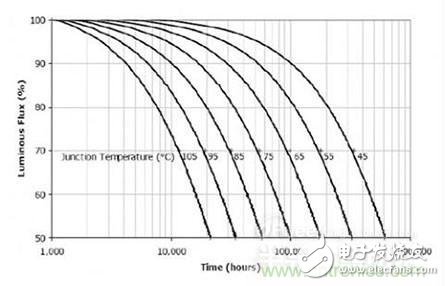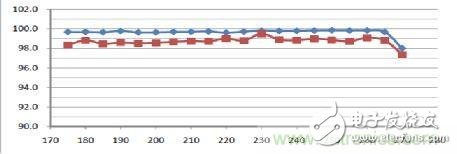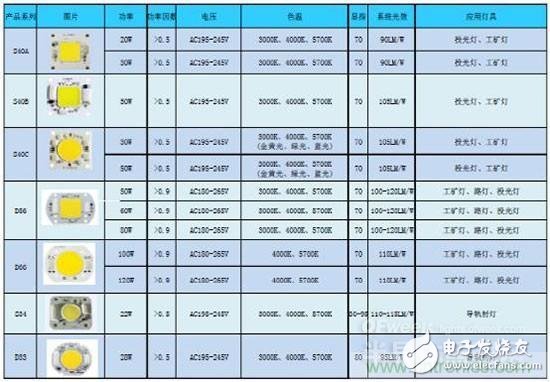However, when we carefully understand what is the "powerless AC LED light engine", it is another new formula for the "electroless capacitor light engine" that has long been criticized.
A light engine using a linear constant current source
In fact, many so-called "powerless light engines" are light engines with linear constant current sources. Now we take a look at several such powerless AC LED light engines found on Alibaba.

The picture above is a screenshot taken on the Alibaba website at the following URL. The figure clearly shows the "220V AC input without power supply" photoelectric engine. In fact, you can see that there are a lot of power chips in the center of the board, including rectifier bridges, segmented high-voltage linear constant current source chips and so on. So it should be said that this is just the kind of "electroless capacitor light engine" that I used to move the linear constant current source to the aluminum substrate. It is basically an ordinary high-voltage linear constant current source. The advantage of a linear constant current source is that there are few components and it is not easy to block light, but its biggest disadvantage is that the efficiency is extremely low, usually only about 80-85%. Moreover, the bigger problem is that such an inefficient linear power supply is placed on the aluminum substrate, so that all the heat generated by it is added to the aluminum substrate, which increases the ambient temperature of the LED, thereby increasing the junction temperature of the LED. Not only reduces the thermal efficacy of the LED (that is, the light efficiency measured after the lamp is thermally stable) but also reduces the life of the LED. Moreover, it has obvious 100Hz flicker, which will damage the vision of humans, especially children. The United States has explicitly banned LED light sources with flash frequencies below 150Hz.
2. The thermal efficacy of the AC light engine
We tested the thermal efficacy of an AC light engine from a Shenzhen company and found that its thermal efficacy was 17.5% lower than the cold light effect at the start. At present, it can be said that the light effects indicated by most companies are cold light effects. Almost all users will be lit for more than 3 quarters, so the actual light effect after three minutes of lighting is only 82.5% of the indicator light efficiency. This is actually inadvertently deceiving consumers. Therefore, in order to be responsible for consumers, all manufacturers who use such a so-called "AC light engine" to make LED lamps must be required to indicate the value of their thermal efficacy.
Three. AC light engine life
We know that the lifetime of an LED is entirely determined by its junction temperature. Cree, USA, gives a plot of junction temperature and lifetime.

As long as you know the junction temperature, you can know the life expectancy. Assuming that the junction temperature is 85 degrees when the power supply is not on the aluminum substrate, the lifetime is about 30,000 hours. Now put the linear constant current source on the aluminum substrate. If the efficiency of this linear constant current source is 85%, it means that 15% of the loss becomes heat, which immediately increases the heat of the aluminum substrate by 15%. The temperature also increased by 15%, which is from 85 degrees to 98 degrees. Life expectancy has been reduced from 30,000 hours to 15,000 hours. It is also reduced by half!
So the price of this so-called "AC powerless light engine" is to reduce the thermal efficiency by 17.5% and cut the life by half!
Effie's high efficiency light engine
From here we can know that it is not simply to put any constant current source on the aluminum substrate to become a light engine. The basic condition for placing the constant current source on the aluminum substrate is that its efficiency must be so high that it does not increase at all. The heat of the aluminum substrate. Effie has invented such a constant current source with an efficiency of up to 99%.

The blue color in the figure is the efficiency of the constant current source itself, and the red is the efficiency of all the power sources including the rectifier. It can be seen from the figure that when the mains voltage is increased from 175V to 265V, its efficiency has been maintained above 99%. Such a high-efficiency constant current source will not substantially increase the heat of the aluminum substrate after being placed on the aluminum substrate, and will not lower the thermal efficiency of the light engine, nor will it reduce the life of the light engine! Efficiency does not change with temperature:
When the ambient temperature is raised from 35 degrees to 85 degrees, its total efficiency has been above 98%.
Moreover, the power of the Effie light engine does not change with the mains voltage and voltage.

5. Effie's various efficient light engines
At present, Effie has produced a variety of high-efficiency light engines from 8W up to 160W. The brief parameters are shown in the table below. Most of its luminous efficacy is 100-120lm/W, which is much higher than the "AC light engine" of electroless capacitors, and its thermal efficiency is higher than that of "AC light engine" (see the author's other "LED light" The thermal effect of the engine").

Conclusion
Unfortunately, the current "AC light engine" for electroless capacitors is already on the market. Because many customers don't understand that it has so many problems and shortcomings. Manufacturers have also intentionally or unintentionally concealed these problems and shortcomings. Some people even put forward "de-powering" to fool customers, this practice must be debunked and restored to its true colors!
Counterweight Material,Tungsten Heavy Alloy,Crane Counterweight Material,Forklift Counterweight Material
Shaanxi Xinlong Metal Electro-mechanical Co., Ltd. , https://www.cnxlalloyproduct.com